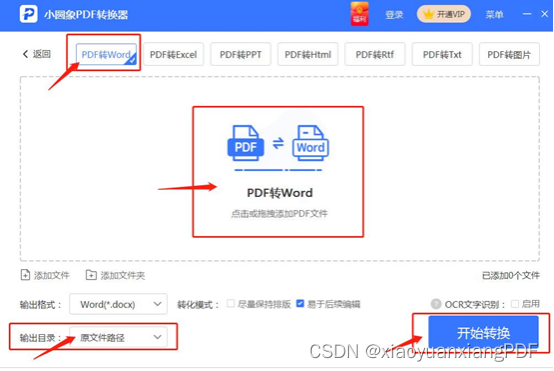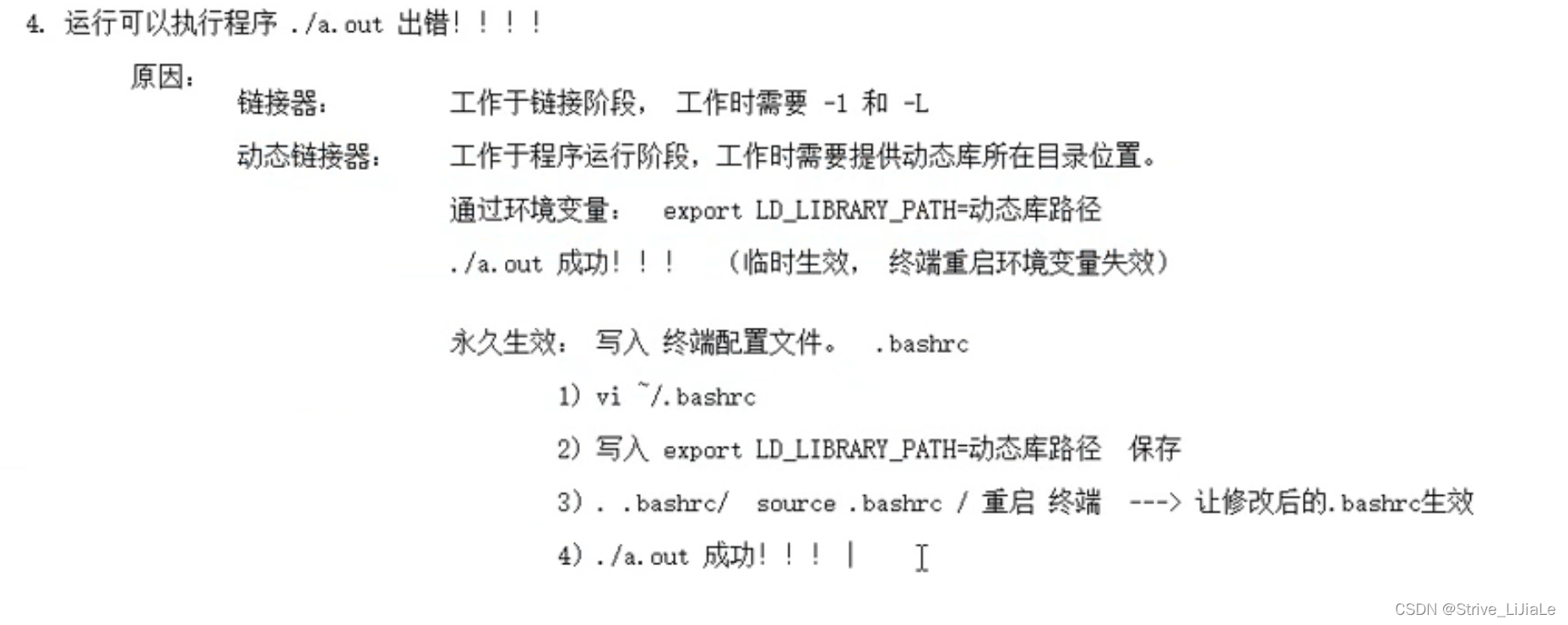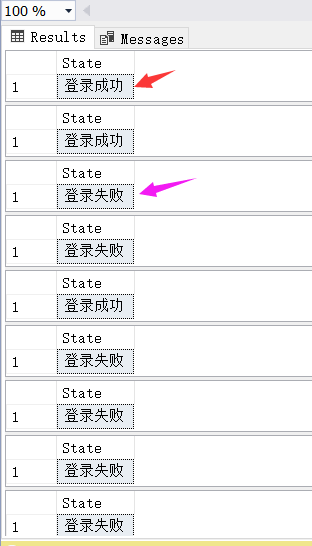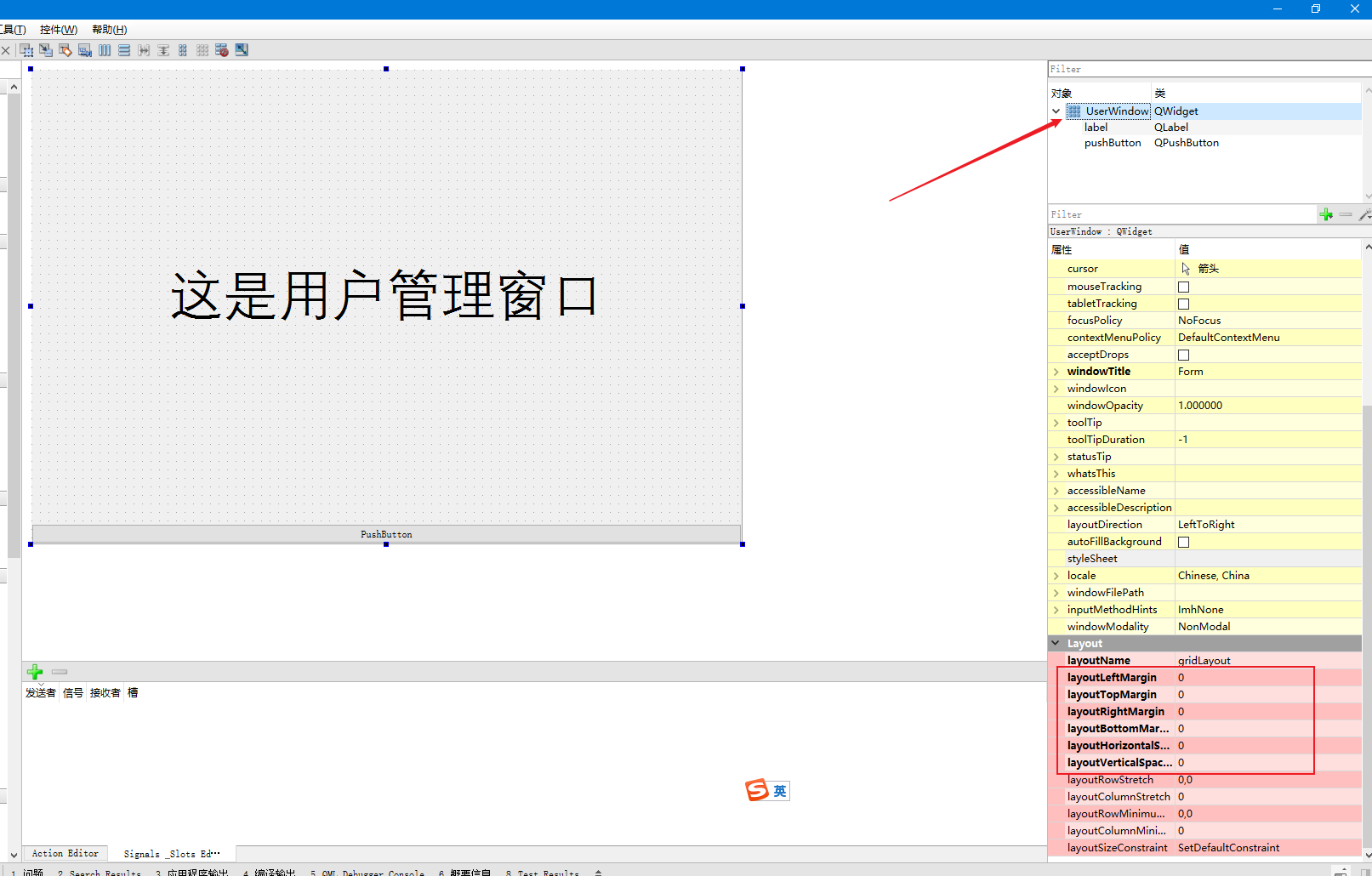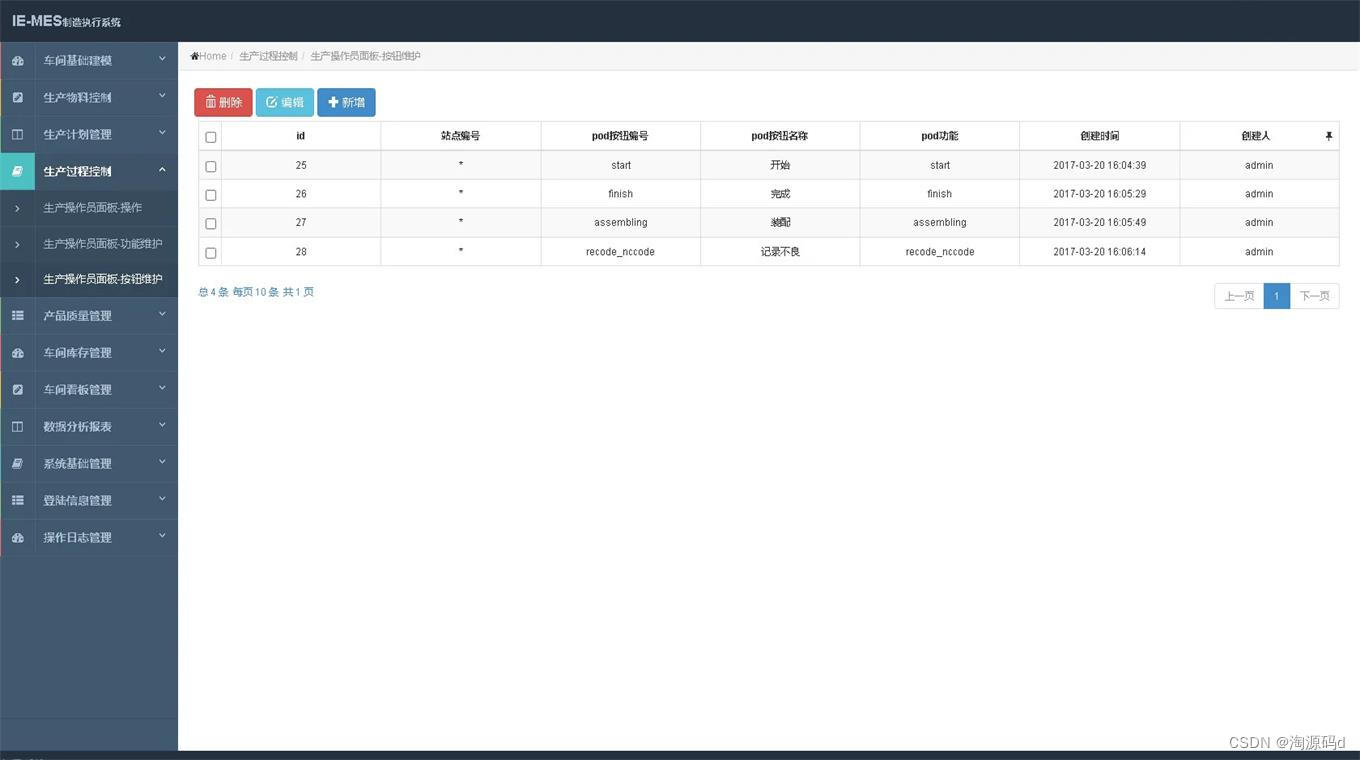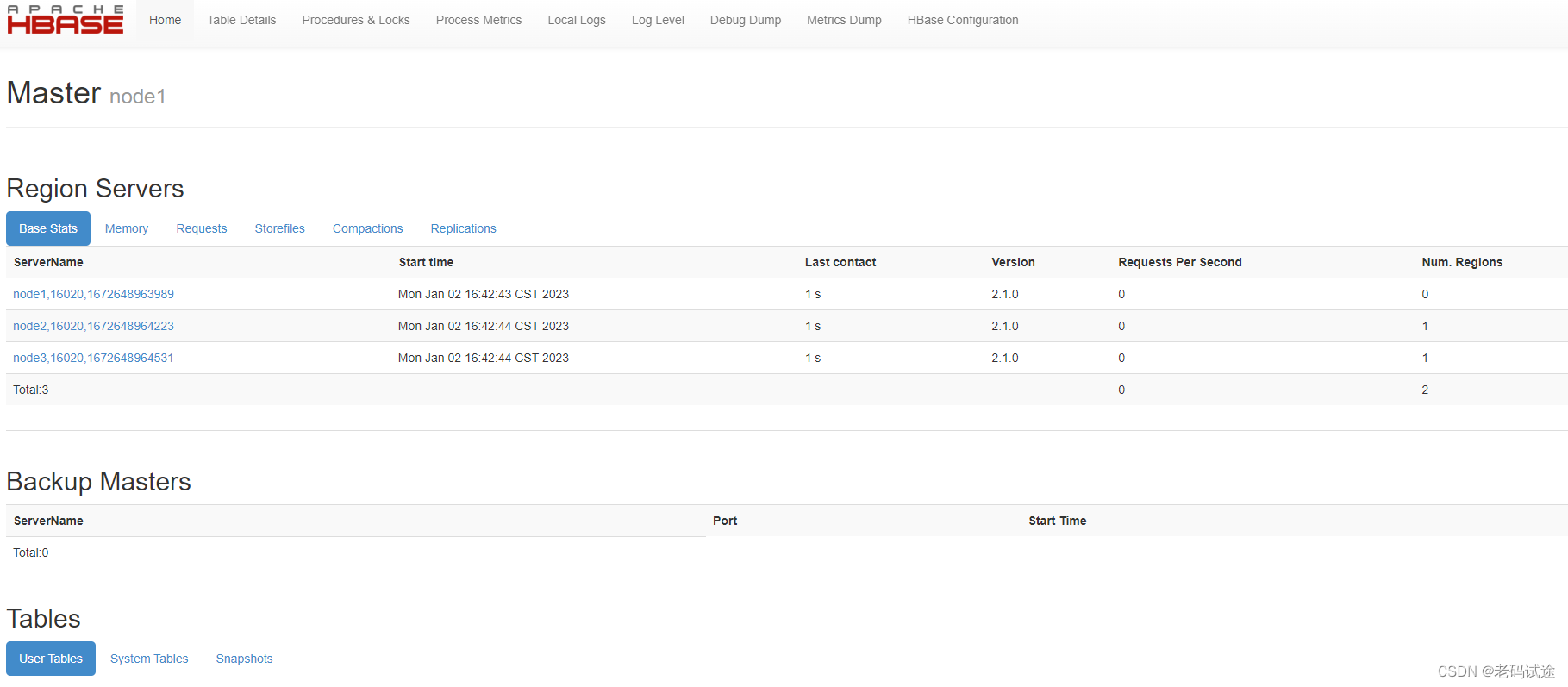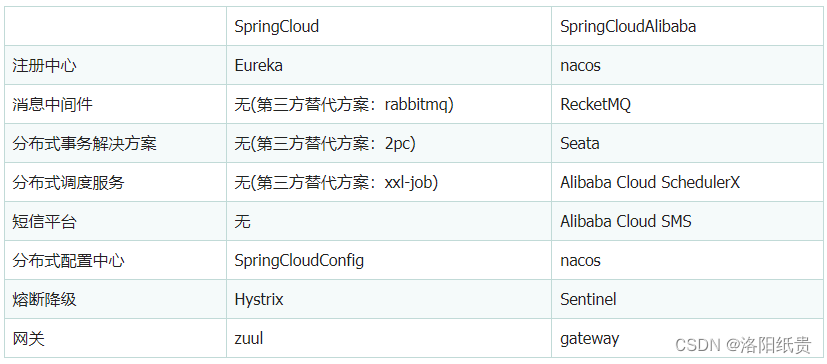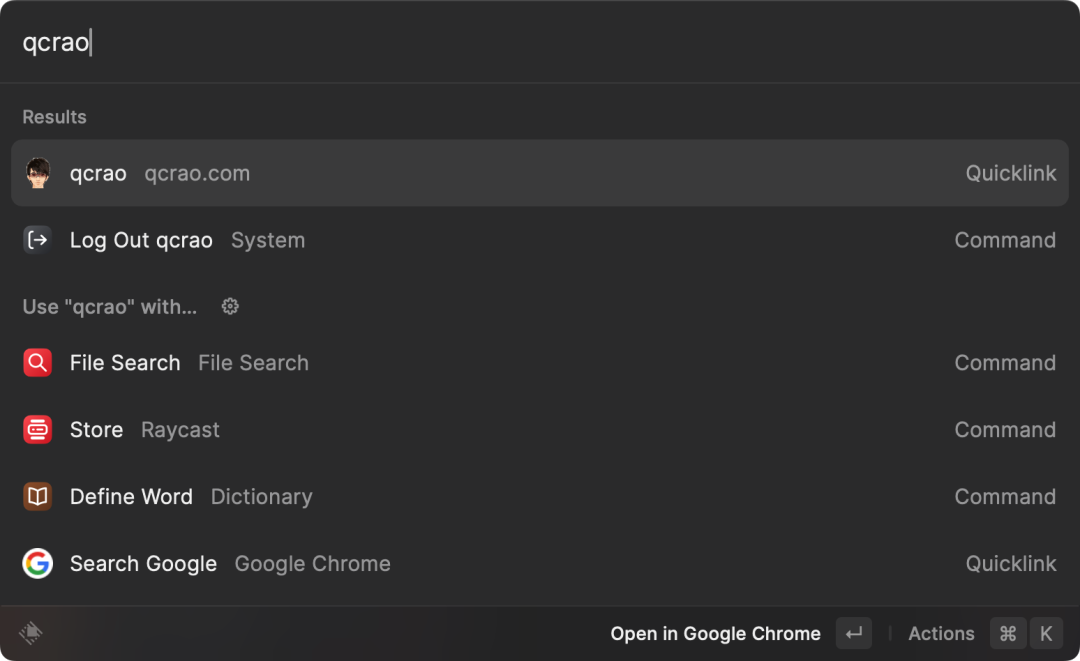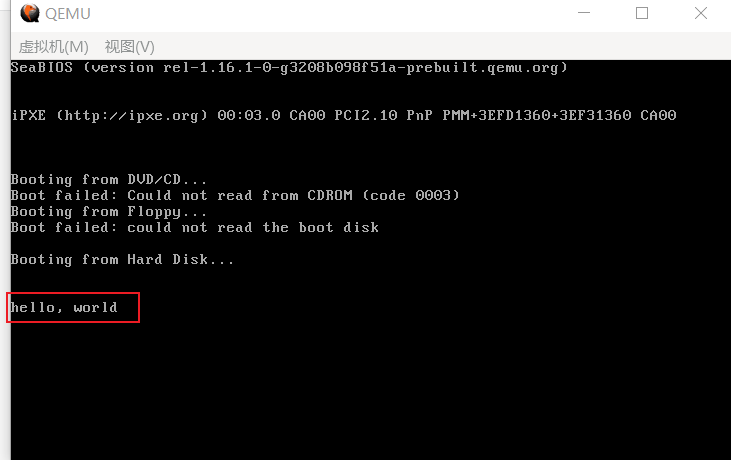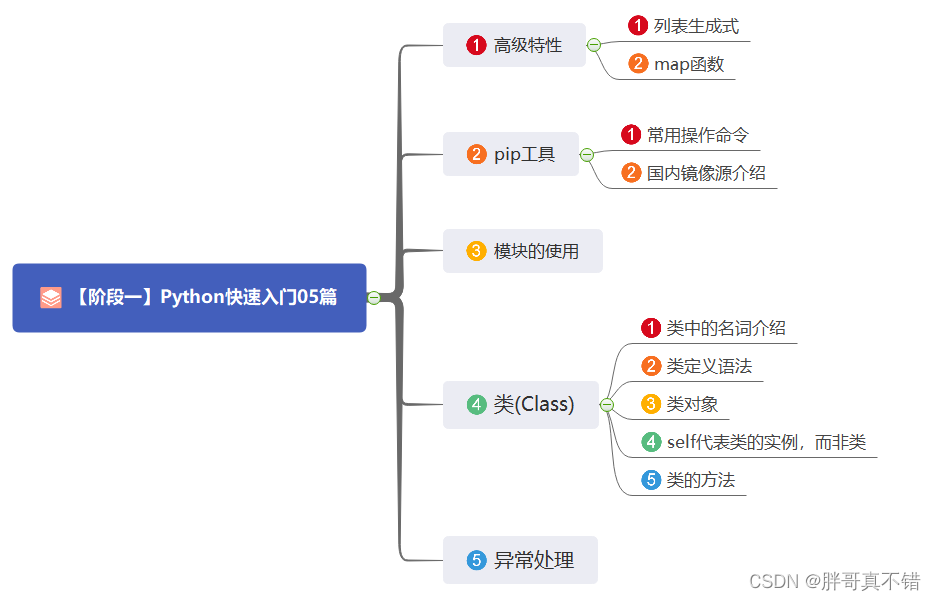学更好的别人,
做更好的自己。
——《微卡智享》

本文长度为4239字,预计阅读12分钟
前言
前面几篇文章实现了pyTorch训练模型,然后在Windows平台用C++ OpenCV DNN推理都实现了,这篇就来看看在Android端直接实现一个手写数字识别的功能。本篇最后会放出源码地址。

实现效果
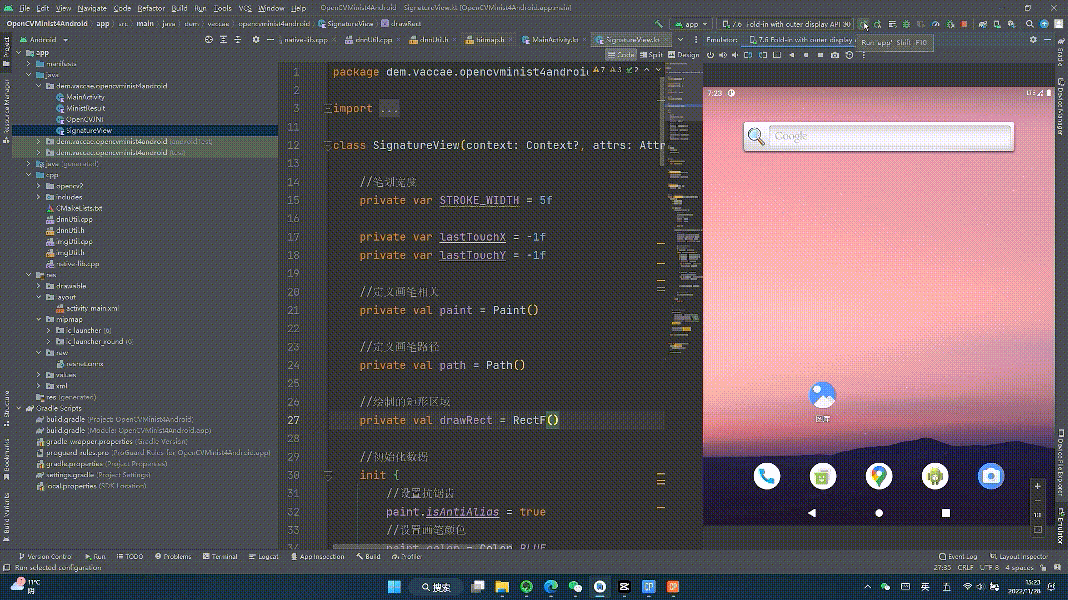
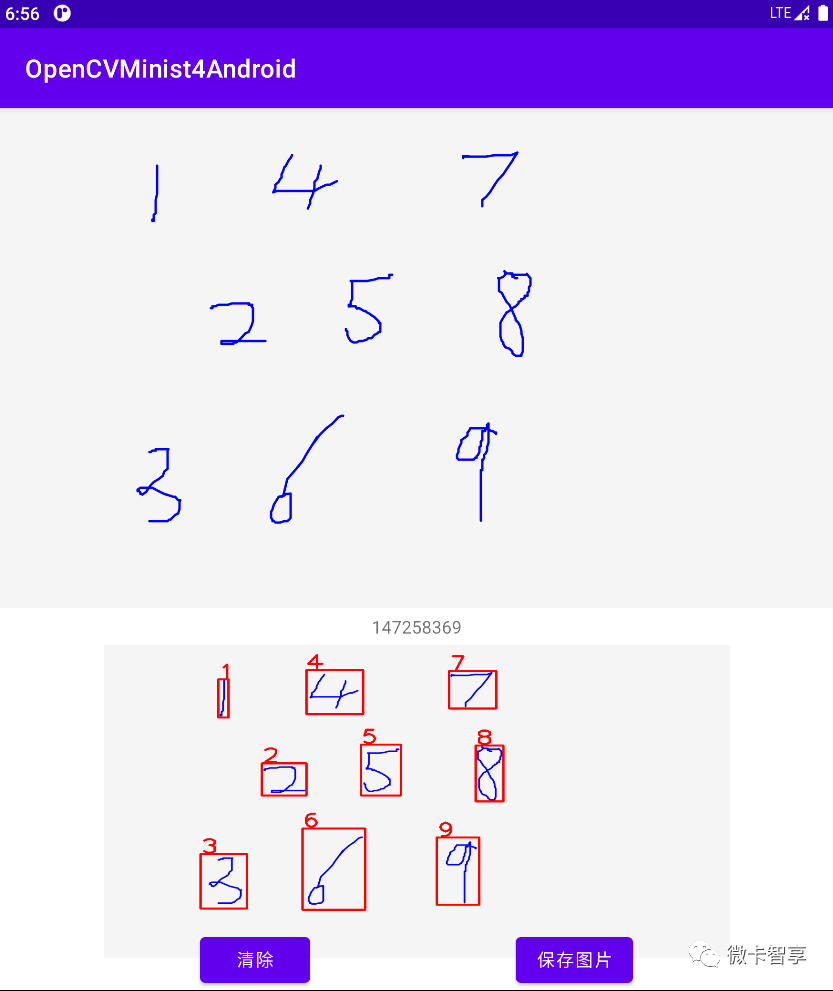
代码实现

微卡智享
实现Android端后写数字识别,一个是项目的OpenCV的环境搭建,详细的搭建可以看《OpenCV4Android中NDK开发(一)--- OpenCV4.1.0环境搭建》,这里只做一下简单介绍了。另一个就是手写板的实现,手写板在前面的《Android Kotlin制作签名白板并保存图片》中已经完成,这次直接将里面现成的类拿过来用即可。
01
项目配置
创建的项目是Native C++的项目,所以cpp文件夹这些都已经创建好了。OpenCV是从官网直接下载的Andorid版本,用的是最新的4.6版本
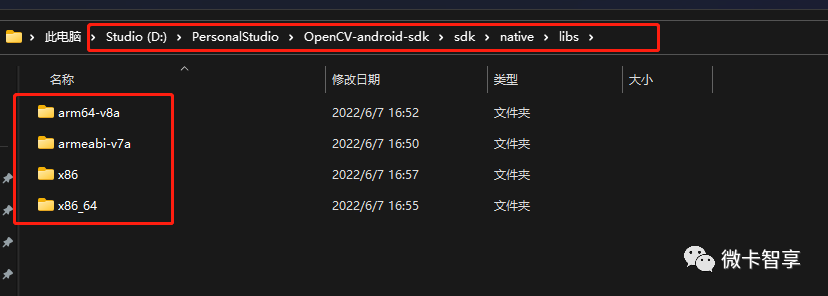
下载好的OpenCV4.6 Android SDK

将里面动态库拷贝到项目目录下的libs下,这里我只拷了3个CPU架构的,因为用虚拟机,所以加上了x86


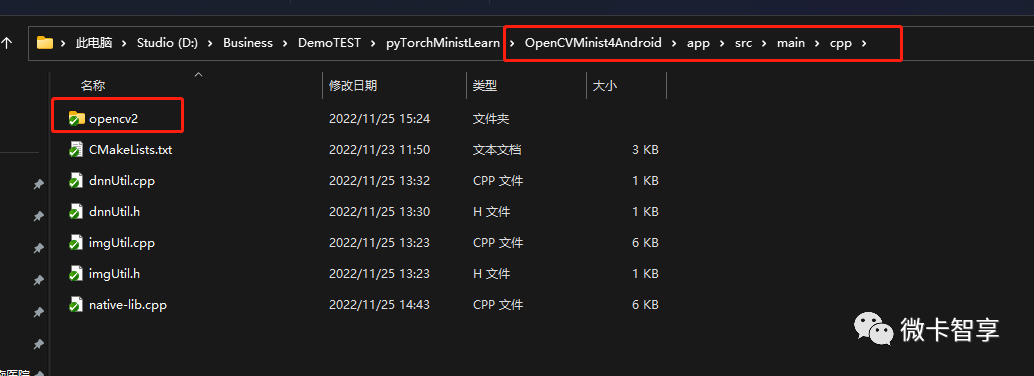
然后将OpenCV Android SDK里面的OpenCV头文件复制到程序目录的cpp文件夹下
配置CMakeLists
# For more information about using CMake with Android Studio, read the
# documentation: https://d.android.com/studio/projects/add-native-code.html
# Sets the minimum version of CMake required to build the native library.
cmake_minimum_required(VERSION 3.18.1)
# Declares and names the project.
project("opencvminist4android")
#定义变量opencvlibs使后面的命令可以使用定位具体的库文件
set(opencvlibs ${CMAKE_CURRENT_SOURCE_DIR}/../../../libs)
#调用头文件的具体路径
include_directories(${CMAKE_CURRENT_SOURCE_DIR})
#增加OpenCV的动态库
add_library(libopencv_java4 SHARED IMPORTED)
#建立链接
set_target_properties(libopencv_java4 PROPERTIES IMPORTED_LOCATION
"${opencvlibs}/${ANDROID_ABI}/libopencv_java4.so")
# Creates and names a library, sets it as either STATIC
# or SHARED, and provides the relative paths to its source code.
# You can define multiple libraries, and CMake builds them for you.
# Gradle automatically packages shared libraries with your APK.
file(GLOB native_srcs "*.cpp")
add_library( # Sets the name of the library.
opencvminist4android
# Sets the library as a shared library.
SHARED
# Provides a relative path to your source file(s).
${native_srcs})
# Searches for a specified prebuilt library and stores the path as a
# variable. Because CMake includes system libraries in the search path by
# default, you only need to specify the name of the public NDK library
# you want to add. CMake verifies that the library exists before
# completing its build.
find_library( # Sets the name of the path variable.
log-lib
# Specifies the name of the NDK library that
# you want CMake to locate.
log)
# Specifies libraries CMake should link to your target library. You
# can link multiple libraries, such as libraries you define in this
# build script, prebuilt third-party libraries, or system libraries.
target_link_libraries( # Specifies the target library.
opencvminist4android
jnigraphics
libopencv_java4
# Links the target library to the log library
# included in the NDK.
${log-lib})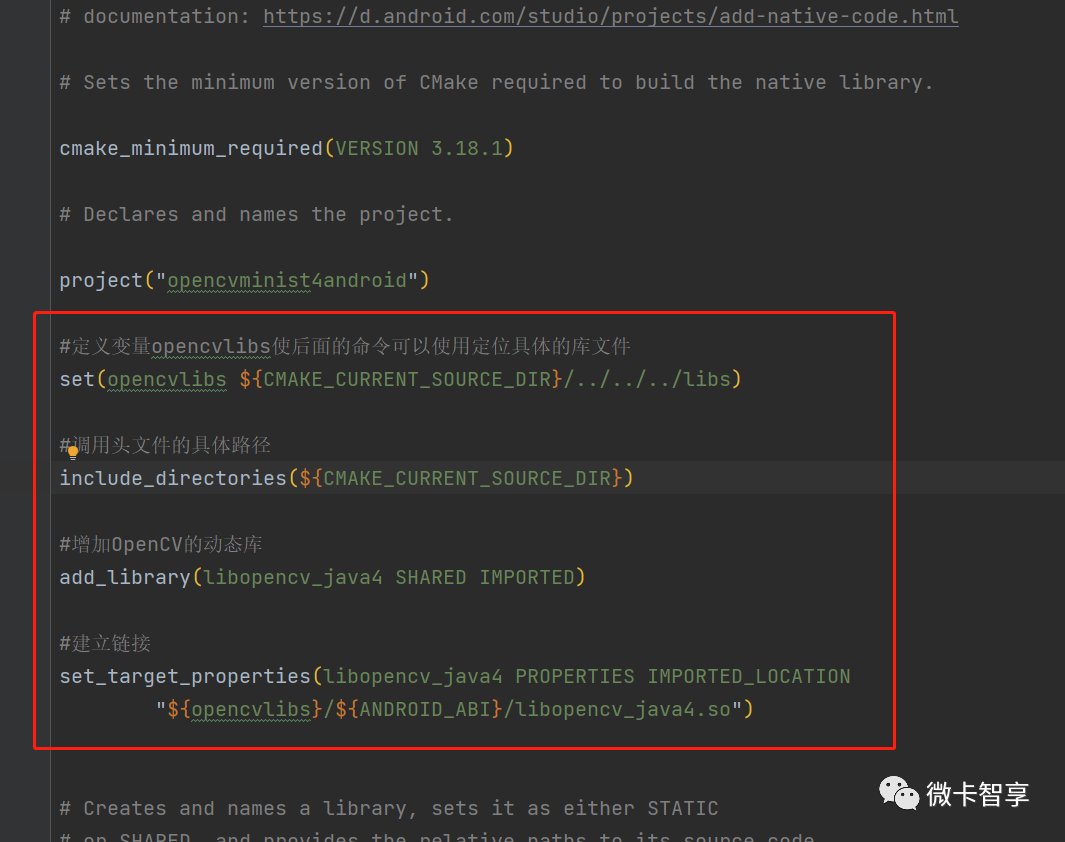
build.gradle中要加入相关的配置
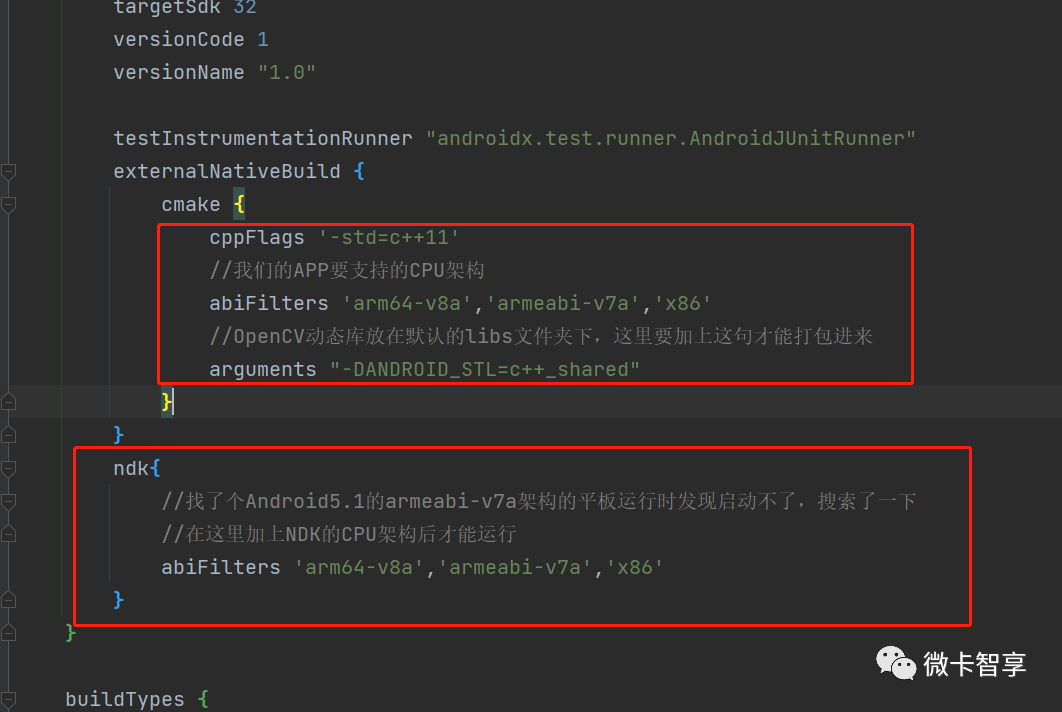
02
C++中的代码处理
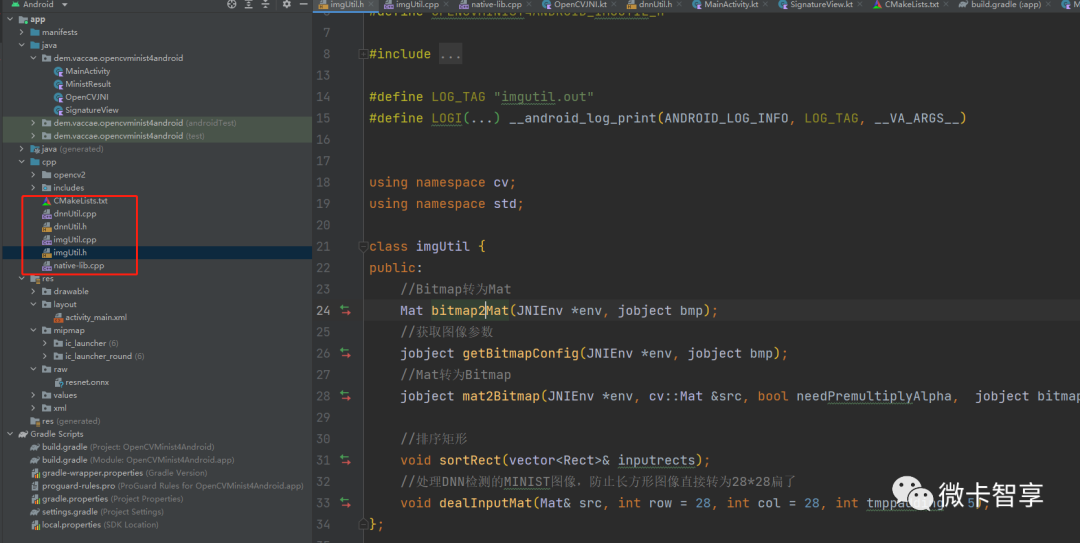
图中看到native-lib.cpp是JNI中的入口,而这里创建了两个C++的类imgUtil和dnnUtil,一个是图像的处理,一个是DNN推理用的类。
imgUtil类
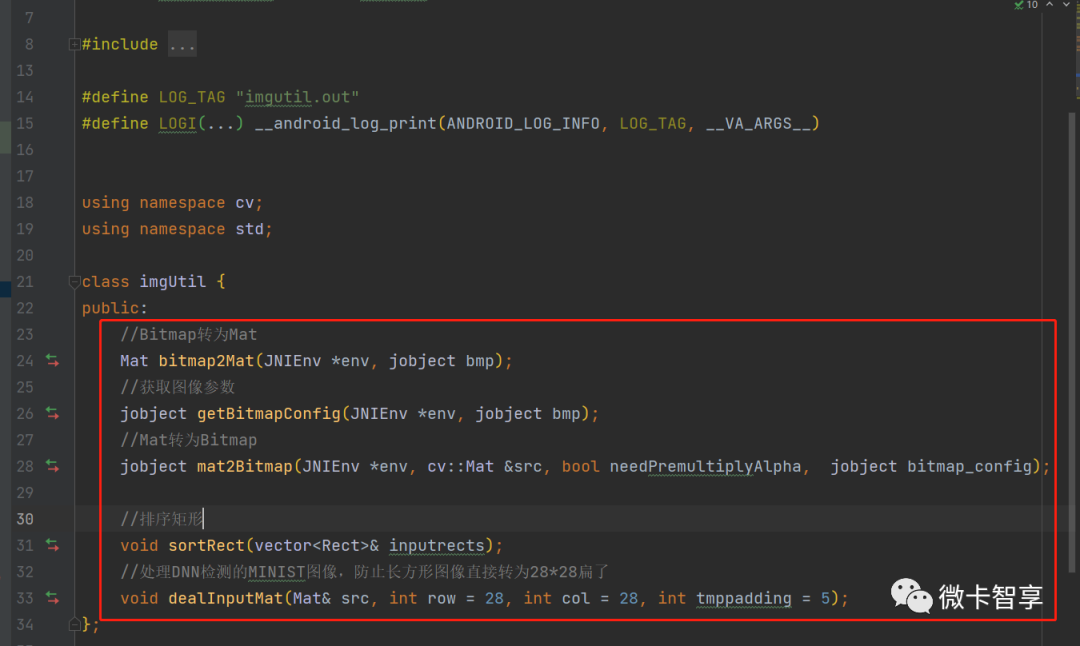
几个函数中下面的sortRect和dealInputMat这两个函数就是前面章里面用到的函数,这里将他们放到这个类里面了。而Android中保存的bitmap图像在OpenCV中需要进行转换处理,所以上面的三个函数是bitmap和Mat之间相互转换用的。
#include "imgUtil.h"
//Bitmap转为Mat
Mat imgUtil::bitmap2Mat(JNIEnv *env, jobject bmp) {
Mat src;
AndroidBitmapInfo bitmapInfo;
void *pixelscolor;
int ret;
try {
//获取图像信息,如果返回值小于0就是执行失败
if ((ret = AndroidBitmap_getInfo(env, bmp, &bitmapInfo)) < 0) {
LOGI("AndroidBitmap_getInfo failed! error-%d", ret);
return src;
}
//判断图像类型是不是RGBA_8888类型
if (bitmapInfo.format != ANDROID_BITMAP_FORMAT_RGBA_8888) {
LOGI("BitmapInfoFormat error");
return src;
}
//获取图像像素值
if ((ret = AndroidBitmap_lockPixels(env, bmp, &pixelscolor)) < 0) {
LOGI("AndroidBitmap_lockPixels() failed ! error=%d", ret);
return src;
}
//生成源图像
src = Mat(bitmapInfo.height, bitmapInfo.width, CV_8UC4, pixelscolor);
return src;
} catch (Exception e) {
jclass je = env->FindClass("java/lang/Exception");
env->ThrowNew(je, e.what());
return src;
} catch (...) {
jclass je = env->FindClass("java/lang/Exception");
env->ThrowNew(je, "Unknown exception in JNI code {bitmap2Mat}");
return src;
}
}
//获取Bitmap的参数
jobject imgUtil::getBitmapConfig(JNIEnv *env, jobject bmp) {
//获取原图片的参数
jclass java_bitmap_class = (jclass) env->FindClass("android/graphics/Bitmap");
jmethodID mid = env->GetMethodID(java_bitmap_class, "getConfig",
"()Landroid/graphics/Bitmap$Config;");
jobject bitmap_config = env->CallObjectMethod(bmp, mid);
return bitmap_config;
}
//Mat转为Bitmap
jobject
imgUtil::mat2Bitmap(JNIEnv *env, Mat &src, bool needPremultiplyAlpha, jobject bitmap_config) {
jclass java_bitmap_class = (jclass) env->FindClass("android/graphics/Bitmap");
jmethodID mid = env->GetStaticMethodID(java_bitmap_class, "createBitmap",
"(IILandroid/graphics/Bitmap$Config;)Landroid/graphics/Bitmap;");
jobject bitmap = env->CallStaticObjectMethod(java_bitmap_class,
mid, src.size().width, src.size().height,
bitmap_config);
AndroidBitmapInfo info;
void *pixels = 0;
try {
CV_Assert(AndroidBitmap_getInfo(env, bitmap, &info) >= 0);
CV_Assert(src.type() == CV_8UC1 || src.type() == CV_8UC3 || src.type() == CV_8UC4);
CV_Assert(AndroidBitmap_lockPixels(env, bitmap, &pixels) >= 0);
CV_Assert(pixels);
if (info.format == ANDROID_BITMAP_FORMAT_RGBA_8888) {
cv::Mat tmp(info.height, info.width, CV_8UC4, pixels);
if (src.type() == CV_8UC1) {
cvtColor(src, tmp, cv::COLOR_GRAY2RGBA);
} else if (src.type() == CV_8UC3) {
cvtColor(src, tmp, cv::COLOR_RGB2BGRA);
} else if (src.type() == CV_8UC4) {
if (needPremultiplyAlpha) {
cvtColor(src, tmp, cv::COLOR_RGBA2mRGBA);
} else {
src.copyTo(tmp);
}
}
} else {
// info.format == ANDROID_BITMAP_FORMAT_RGB_565
cv::Mat tmp(info.height, info.width, CV_8UC2, pixels);
if (src.type() == CV_8UC1) {
cvtColor(src, tmp, cv::COLOR_GRAY2BGR565);
} else if (src.type() == CV_8UC3) {
cvtColor(src, tmp, cv::COLOR_RGB2BGR565);
} else if (src.type() == CV_8UC4) {
cvtColor(src, tmp, cv::COLOR_RGBA2BGR565);
}
}
AndroidBitmap_unlockPixels(env, bitmap);
return bitmap;
} catch (Exception e) {
AndroidBitmap_unlockPixels(env, bitmap);
jclass je = env->FindClass("java/lang/Exception");
env->ThrowNew(je, e.what());
return bitmap;
} catch (...) {
AndroidBitmap_unlockPixels(env, bitmap);
jclass je = env->FindClass("java/lang/Exception");
env->ThrowNew(je, "Unknown exception in JNI code {nMatToBitmap}");
return bitmap;
}
}
//排序矩形
void imgUtil::sortRect(vector<Rect> &inputrects) {
for (int i = 0; i < inputrects.size(); ++i) {
for (int j = i; j < inputrects.size(); ++j) {
//说明顺序在上方,这里不用变
if (inputrects[i].y + inputrects[i].height < inputrects[i].y) {
}
//同一排
else if (inputrects[i].y <= inputrects[j].y + inputrects[j].height) {
if (inputrects[i].x > inputrects[j].x) {
swap(inputrects[i], inputrects[j]);
}
}
//下一排
else if (inputrects[i].y > inputrects[j].y + inputrects[j].height) {
swap(inputrects[i], inputrects[j]);
}
}
}
}
//处理DNN检测的MINIST图像,防止长方形图像直接转为28*28扁了
void imgUtil::dealInputMat(Mat &src, int row, int col, int tmppadding) {
int w = src.cols;
int h = src.rows;
//看图像的宽高对比,进行处理,先用padding填充黑色,保证图像接近正方形,这样缩放28*28比例不会失衡
if (w > h) {
int tmptopbottompadding = (w - h) / 2 + tmppadding;
copyMakeBorder(src, src, tmptopbottompadding, tmptopbottompadding, tmppadding, tmppadding,
BORDER_CONSTANT, Scalar(0));
}
else {
int tmpleftrightpadding = (h - w) / 2 + tmppadding;
copyMakeBorder(src, src, tmppadding, tmppadding, tmpleftrightpadding, tmpleftrightpadding,
BORDER_CONSTANT, Scalar(0));
}
resize(src, src, Size(row, col));
}dnnUtil类

Dnn推理类中,只有两个函数,一个是初始化,也就是加载模型,需要读取本地的模型文件加载进来。另一个就是推理的函数。
关于模型文件
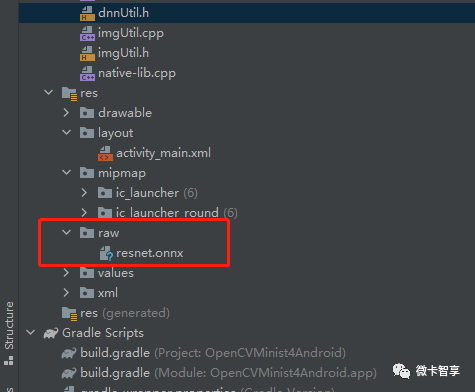
上图中可以看到,模型文件选择我们在训练中识别率最高的ResNet的模型,将模型文件直接复制进了raw资源下,注意原来创建时文件名有大写,在这里面要全部改为小写。在Android端程序启动的时候先读取资源文件,再将模型拷贝到本地,把路径通过JNI传递到C++里面,初始化即可。
#include "dnnUtil.h"
bool dnnUtil::InitDnnNet(string onnxdesc) {
_onnxdesc = onnxdesc;
_net = dnn::readNetFromONNX(_onnxdesc);
_net.setPreferableTarget(dnn::DNN_TARGET_CPU);
return !_net.empty();
}
Mat dnnUtil::DnnPredict(Mat src) {
Mat inputBlob = dnn::blobFromImage(src, 1, Size(28, 28), Scalar(), false, false);
//输入参数值
_net.setInput(inputBlob, "input");
//预测结果
Mat output = _net.forward("output");
return output;
}JNI入口及native-lib.cpp
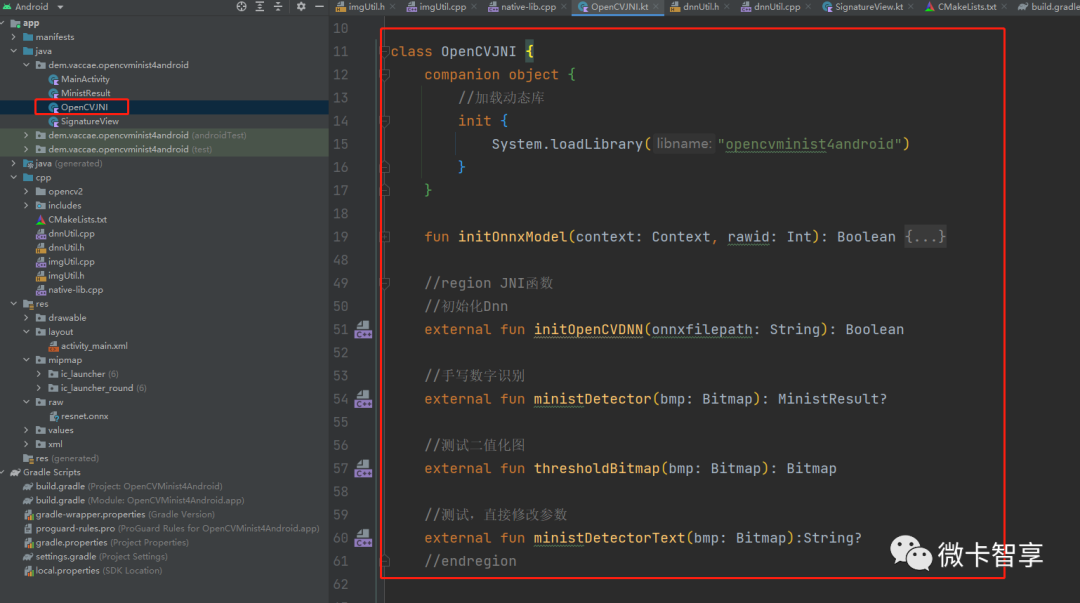
在Android端创建了一个OpenCVJNI的类,入口的函数写了4个,一个初始化DNN,两个识别的函数,还有一个测试用的。
上面说的将资源文件读取拷贝出来,再进行DNN的初始化就是initOnnxModel这个函数实现的,代码如下:
fun initOnnxModel(context: Context, rawid: Int): Boolean {
try {
val onnxDir: File = File(context.filesDir, "onnx")
if (!onnxDir.exists()) {
onnxDir.mkdirs()
}
//判断模型是否存在是否存在,不存在复制过来
val onnxfile: File = File(onnxDir, "dnnNet.onnx")
if (onnxfile.exists()){
return initOpenCVDNN(onnxfile.absolutePath)
}else {
// load cascade file from application resources
val inputStream = context.resources.openRawResource(rawid)
val os: FileOutputStream = FileOutputStream(onnxfile)
val buffer = ByteArray(4096)
var bytesRead: Int
while (inputStream.read(buffer).also { bytesRead = it } != -1) {
os.write(buffer, 0, bytesRead)
}
inputStream.close()
os.close()
return initOpenCVDNN(onnxfile.absolutePath)
}
} catch (e: Exception) {
e.printStackTrace()
return false
}
}external对应到native-lib.cpp中,即下面的源码
#pragma once
#include <jni.h>
#include <string>
#include <android/log.h>
#include <opencv2/opencv.hpp>
#include "dnnUtil.h"
#include "imgUtil.h"
#define LOG_TAG "System.out"
#define LOGI(...) __android_log_print(ANDROID_LOG_INFO, LOG_TAG, __VA_ARGS__)
using namespace cv;
using namespace std;
dnnUtil _dnnUtil;
imgUtil _imgUtil = imgUtil();
extern "C"
JNIEXPORT jboolean JNICALL
Java_dem_vaccae_opencvminist4android_OpenCVJNI_initOpenCVDNN(JNIEnv *env, jobject thiz,
jstring onnxfilepath) {
try {
string onnxfile = env->GetStringUTFChars(onnxfilepath, 0);
//初始化DNN
_dnnUtil = dnnUtil();
jboolean res = _dnnUtil.InitDnnNet(onnxfile);
return res;
} catch (Exception e) {
jclass je = env->FindClass("java/lang/Exception");
env->ThrowNew(je, e.what());
} catch (...) {
jclass je = env->FindClass("java/lang/Exception");
env->ThrowNew(je, "Unknown exception in JNI code {initOpenCVDNN}");
}
}
extern "C"
JNIEXPORT jobject JNICALL
Java_dem_vaccae_opencvminist4android_OpenCVJNI_ministDetector(JNIEnv *env, jobject thiz,
jobject bmp) {
try {
jobject bitmapcofig = _imgUtil.getBitmapConfig(env, bmp);
string resstr = "";
Mat src = _imgUtil.bitmap2Mat(env, bmp);
//备份源图
Mat backsrc;
//将备份的图片从BGRA转为RGB,防止颜色不对
cvtColor(src, backsrc, COLOR_BGRA2RGB);
cvtColor(src, src, COLOR_BGRA2GRAY);
GaussianBlur(src, src, Size(3, 3), 0.5, 0.5);
//二值化图片,注意用THRESH_BINARY_INV改为黑底白字,对应MINIST
threshold(src, src, 0, 255, THRESH_BINARY_INV | THRESH_OTSU);
//做彭账处理,防止手写的数字没有连起来,这里做了3次膨胀处理
Mat kernel = getStructuringElement(MORPH_RECT, Size(3, 3));
//加入开运算先去燥点
morphologyEx(src, src, MORPH_OPEN, kernel, Point(-1, -1));
morphologyEx(src, src, MORPH_DILATE, kernel, Point(-1, -1), 3);
vector<vector<Point>> contours;
vector<Vec4i> hierarchy;
vector<Rect> rects;
//查找轮廓
findContours(src, contours, hierarchy, RETR_EXTERNAL, CHAIN_APPROX_NONE);
for (int i = 0; i < contours.size(); ++i) {
RotatedRect rect = minAreaRect(contours[i]);
Rect outrect = rect.boundingRect();
//插入到矩形列表中
rects.push_back(outrect);
}
//按从左到右,从上到下排序
_imgUtil.sortRect(rects);
//要输出的图像参数
for (int i = 0; i < rects.size(); ++i) {
Mat tmpsrc = src(rects[i]);
_imgUtil.dealInputMat(tmpsrc);
//预测结果
Mat output = _dnnUtil.DnnPredict(tmpsrc);
//查找出结果中推理的最大值
Point maxLoc;
minMaxLoc(output, NULL, NULL, NULL, &maxLoc);
//返回字符串值
resstr += to_string(maxLoc.x);
//画出截取图像位置,并显示识别的数字
rectangle(backsrc, rects[i], Scalar(0, 0, 255), 5);
putText(backsrc, to_string(maxLoc.x), Point(rects[i].x, rects[i].y), FONT_HERSHEY_PLAIN,
5, Scalar(0, 0, 255), 5, -1);
}
jobject resbmp = _imgUtil.mat2Bitmap(env, backsrc, false, bitmapcofig);
//获取MinistResult返回类
jclass ministresultcls = env->FindClass("dem/vaccae/opencvminist4android/MinistResult");
//定义MinistResult返回类属性
jfieldID ministmsg = env->GetFieldID(ministresultcls, "msg", "Ljava/lang/String;");
jfieldID ministbmp = env->GetFieldID(ministresultcls, "bmp", "Landroid/graphics/Bitmap;");
//创建返回类
jobject ministresultobj = env->AllocObject(ministresultcls);
//设置返回消息
env->SetObjectField(ministresultobj, ministmsg, env->NewStringUTF(resstr.c_str()));
//设置返回的图片信息
env->SetObjectField(ministresultobj, ministbmp, resbmp);
AndroidBitmap_unlockPixels(env, bmp);
return ministresultobj;
} catch (Exception e) {
jclass je = env->FindClass("java/lang/Exception");
env->ThrowNew(je, e.what());
} catch (...) {
jclass je = env->FindClass("java/lang/Exception");
env->ThrowNew(je, "Unknown exception in JNI code {bitmap2Mat}");
}
}
extern "C"
JNIEXPORT jobject JNICALL
Java_dem_vaccae_opencvminist4android_OpenCVJNI_thresholdBitmap(JNIEnv *env, jobject thiz,
jobject bmp) {
try {
jobject bitmapcofig = _imgUtil.getBitmapConfig(env, bmp);
Mat src = _imgUtil.bitmap2Mat(env, bmp);
cvtColor(src, src, COLOR_BGRA2GRAY);
threshold(src, src, 0, 255, THRESH_BINARY_INV | THRESH_OTSU);
jobject resbmp = _imgUtil.mat2Bitmap(env, src, false, bitmapcofig);
AndroidBitmap_unlockPixels(env, bmp);
return resbmp;
} catch (Exception e) {
jclass je = env->FindClass("java/lang/Exception");
env->ThrowNew(je, e.what());
} catch (...) {
jclass je = env->FindClass("java/lang/Exception");
env->ThrowNew(je, "Unknown exception in JNI code {bitmap2Mat}");
}
}
extern "C"
JNIEXPORT jstring JNICALL
Java_dem_vaccae_opencvminist4android_OpenCVJNI_ministDetectorText(JNIEnv *env, jobject thiz,
jobject bmp) {
try {
string resstr = "";
//获取图像转为Mat
Mat src = _imgUtil.bitmap2Mat(env, bmp);
//备份源图
Mat backsrc, dst;
//备份用于绘制图像,防止颜色有问题,将BGRA转为RGB
cvtColor(src, dst, COLOR_BGRA2RGB);
//灰度图,处理的图像
cvtColor(src, backsrc, COLOR_BGRA2GRAY);
GaussianBlur(backsrc, backsrc, Size(3, 3), 0.5, 0.5);
//二值化图片,注意用THRESH_BINARY_INV改为黑底白字,对应MINIST
threshold(backsrc, backsrc, 0, 255, THRESH_BINARY_INV | THRESH_OTSU);
//做彭账处理,防止手写的数字没有连起来,这里做了3次膨胀处理
Mat kernel = getStructuringElement(MORPH_RECT, Size(3, 3));
//加入开运算先去燥点
morphologyEx(backsrc, backsrc, MORPH_OPEN, kernel, Point(-1, -1));
morphologyEx(backsrc, backsrc, MORPH_DILATE, kernel, Point(-1, -1), 3);
vector<vector<Point>> contours;
vector<Vec4i> hierarchy;
vector<Rect> rects;
//查找轮廓
findContours(backsrc, contours, hierarchy, RETR_EXTERNAL, CHAIN_APPROX_NONE);
for (int i = 0; i < contours.size(); ++i) {
RotatedRect rect = minAreaRect(contours[i]);
Rect outrect = rect.boundingRect();
//插入到矩形列表中
rects.push_back(outrect);
}
//按从左到右,从上到下排序
_imgUtil.sortRect(rects);
//要输出的图像参数
for (int i = 0; i < rects.size(); ++i) {
Mat tmpsrc = backsrc(rects[i]);
_imgUtil.dealInputMat(tmpsrc);
//预测结果
Mat output = _dnnUtil.DnnPredict(tmpsrc);
//查找出结果中推理的最大值
Point maxLoc;
minMaxLoc(output, NULL, NULL, NULL, &maxLoc);
//返回字符串值
resstr += to_string(maxLoc.x);
//画出截取图像位置,并显示识别的数字
rectangle(dst, rects[i], Scalar(0, 0, 255), 5);
putText(dst, to_string(maxLoc.x), Point(rects[i].x, rects[i].y), FONT_HERSHEY_PLAIN,
5, Scalar(0, 0, 255), 5, -1);
}
//用RGB处理完后的图像,需要转为BGRA再覆盖原来的SRC,这样直接就可以修改源图了
cvtColor(dst, dst, COLOR_RGB2BGRA);
dst.copyTo(src);
AndroidBitmap_unlockPixels(env, bmp);
return env->NewStringUTF(resstr.c_str());
} catch (Exception e) {
jclass je = env->FindClass("java/lang/Exception");
env->ThrowNew(je, e.what());
} catch (...) {
jclass je = env->FindClass("java/lang/Exception");
env->ThrowNew(je, "Unknown exception in JNI code {bitmap2Mat}");
}
}03
Android代码
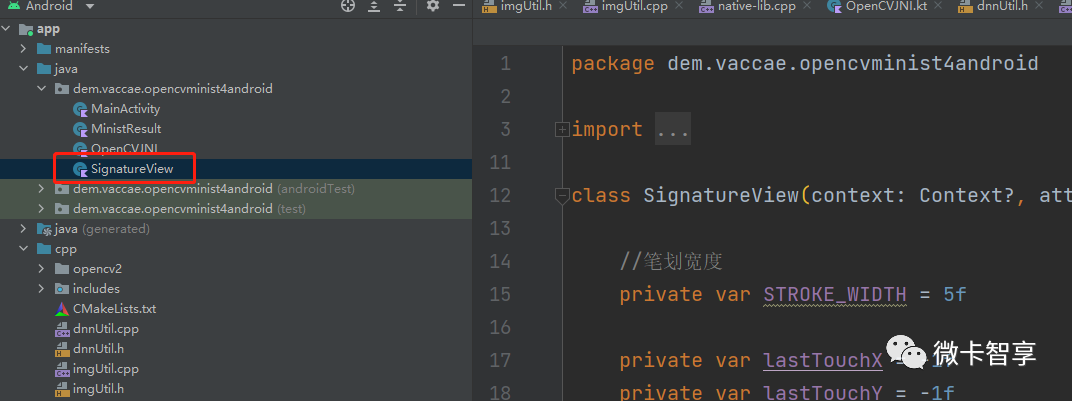
SignatureView是手写板的类,直接从原来那个Demo中拷贝过来了
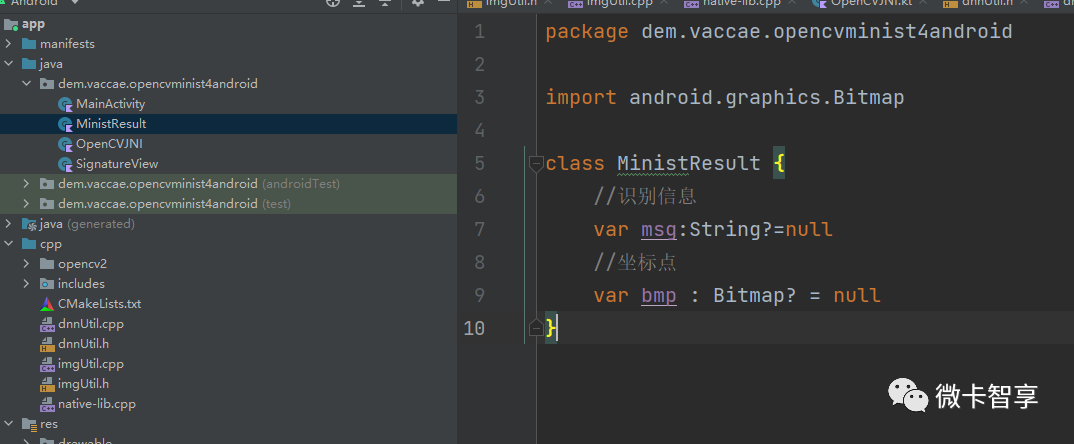
MinistResult类只有两个属性,一个String和一个Bitmap,就是返回的处理后图像和识别的字符串。其实可以直接在原来的Bitmap中修改图像显示,不需要返回类了,那个在JNI中也有实现,只不过既然是练习Demo,就多掌握点知识,直接在NDK中实现返回类的效果。
MainActivity中代码,主要是实现手写即显示的效果,这里直接贴上代码:
package dem.vaccae.opencvminist4android
import android.Manifest
import android.content.pm.PackageManager
import android.graphics.Bitmap
import android.graphics.Color
import androidx.appcompat.app.AppCompatActivity
import android.os.Bundle
import android.widget.ImageView
import android.widget.TextView
import android.widget.Toast
import androidx.core.app.ActivityCompat
import androidx.core.content.ContextCompat
import androidx.core.graphics.createBitmap
import dem.vaccae.opencvminist4android.databinding.ActivityMainBinding
import java.io.File
class MainActivity : AppCompatActivity() {
private lateinit var binding: ActivityMainBinding
private var isInitDNN: Boolean = false
override fun onCreate(savedInstanceState: Bundle?) {
super.onCreate(savedInstanceState)
binding = ActivityMainBinding.inflate(layoutInflater)
setContentView(binding.root)
//初始化DNN
isInitDNN = try {
val jni = OpenCVJNI()
val res = jni.initOnnxModel(this, R.raw.resnet)
binding.tvshow.text = if(res){
"OpenCV DNN初始化成功"
}else{
"OpenCV DNN初始化失败"
}
res
} catch (e: Exception) {
binding.tvshow.text = e.message
false
}
binding.signatureView.setBackgroundColor(Color.rgb(245, 245, 245))
binding.btnclear.setOnClickListener {
binding.signatureView.clear()
}
binding.btnSave.setOnClickListener {
if(!isInitDNN) return@setOnClickListener
val bmp = binding.signatureView.getBitmapFromView()
//处理图像
val ministres:MinistResult? = try{
val jni = OpenCVJNI()
jni.ministDetector(bmp)
}catch (e:Exception){
binding.tvshow.text = e.message
null
}
ministres?.let {
binding.tvshow.text = it.msg
binding.imgv.scaleType = ImageView.ScaleType.FIT_XY
binding.imgv.setImageBitmap(it.bmp)
}
// val strres = try{
// val jni = OpenCVJNI()
// jni.ministDetectorText(bmp)
// }catch (e:Exception){
// binding.tvshow.text = e.message
// null
// }
//
// strres?.let {
// binding.tvshow.text = it
// binding.imgv.scaleType = ImageView.ScaleType.FIT_XY
// binding.imgv.setImageBitmap(bmp)
// }
}
}
}微卡智享
划重点
关于NDK中返回类
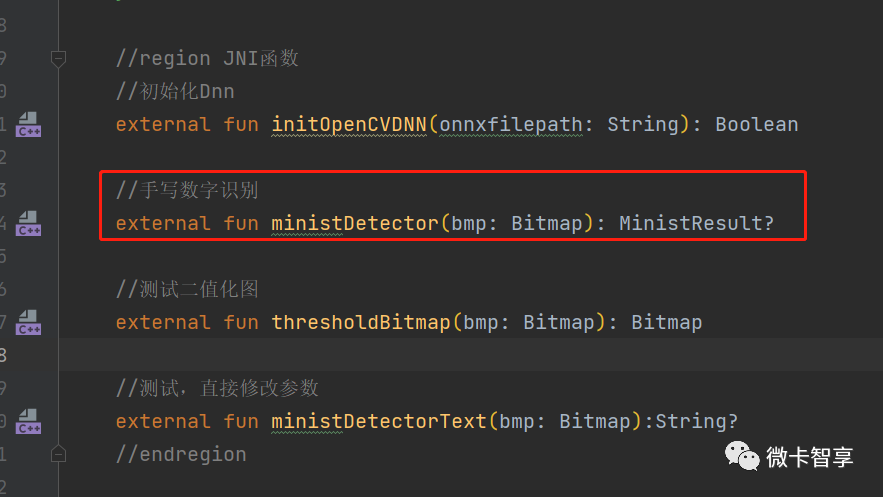
上面的JNI即返回的是MinistResult的类,在NDK中就需要进行处理了,如下图:
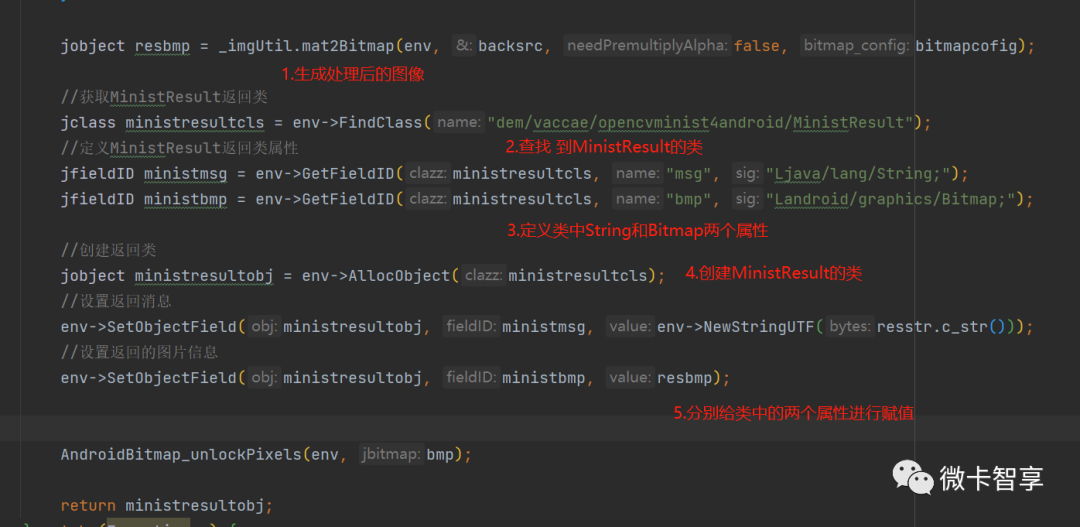
关于Bitmap到NDK中Mat的处理
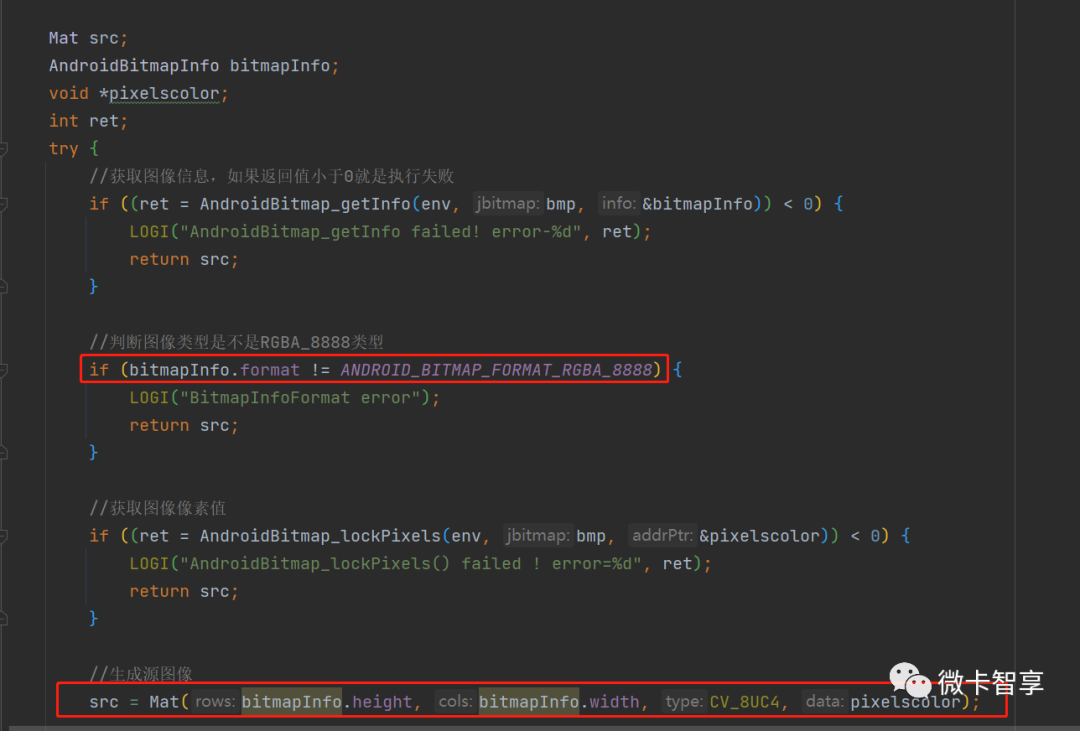
将Bitmap转为Mat,图像的类型是RGBA_8888,所以生成的Mat是8UC4,而在做图像处理的时候,OpenCV的RGB是倒过来的,即BGR,所以cvtColor时,要从BGRA进行转换,如下图:
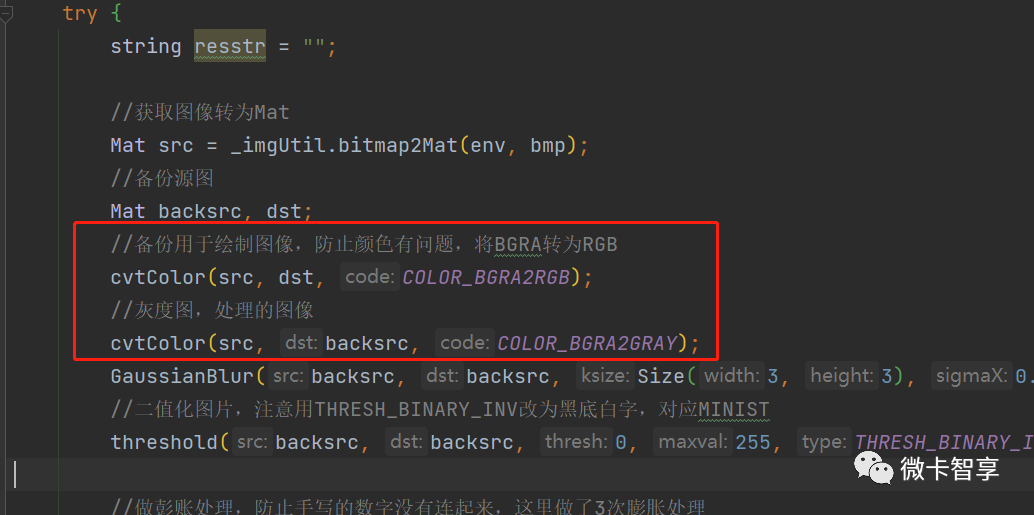
这里做了两次转换,dst从BGRA转为RGB,是用于标记出轮廓的框和识别的数字标识,如果这里不转为RGB,标出的轮廓框和字符的颜色有问题。
而backsrc中从BGRA转为GRAY灰度图,则是进行图像的正常处理了。
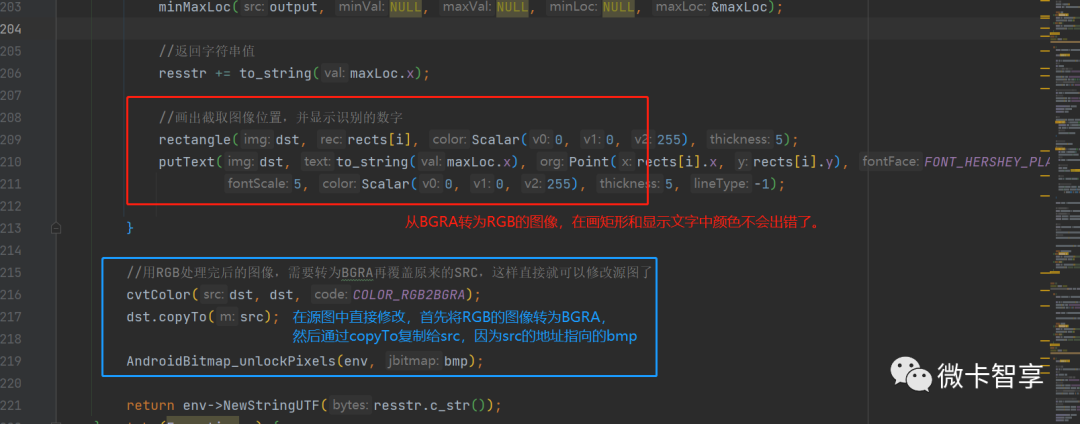
而处理完的dst图像需要先从RGB转换为BGRA,然后再通过CopyTo赋值给src,因为Src地址才是指向我们传入的bitmap,只有修改了src,原来的bitmap才会进行修改。处理完src后,需要再通过AndroidBitmap_unlockPixels供Android端继续使用。
这样一个Android端的手写数字识别的Demo就完成了,文章只是说了一些重点的地方,具体的实现可以通过下载源码运行看看。源码中包括了pyTorch的训练,VS中C++ OpenCV的推理及生成训练图片,及我们现在这个Android的手写数字识别的完整Demo。
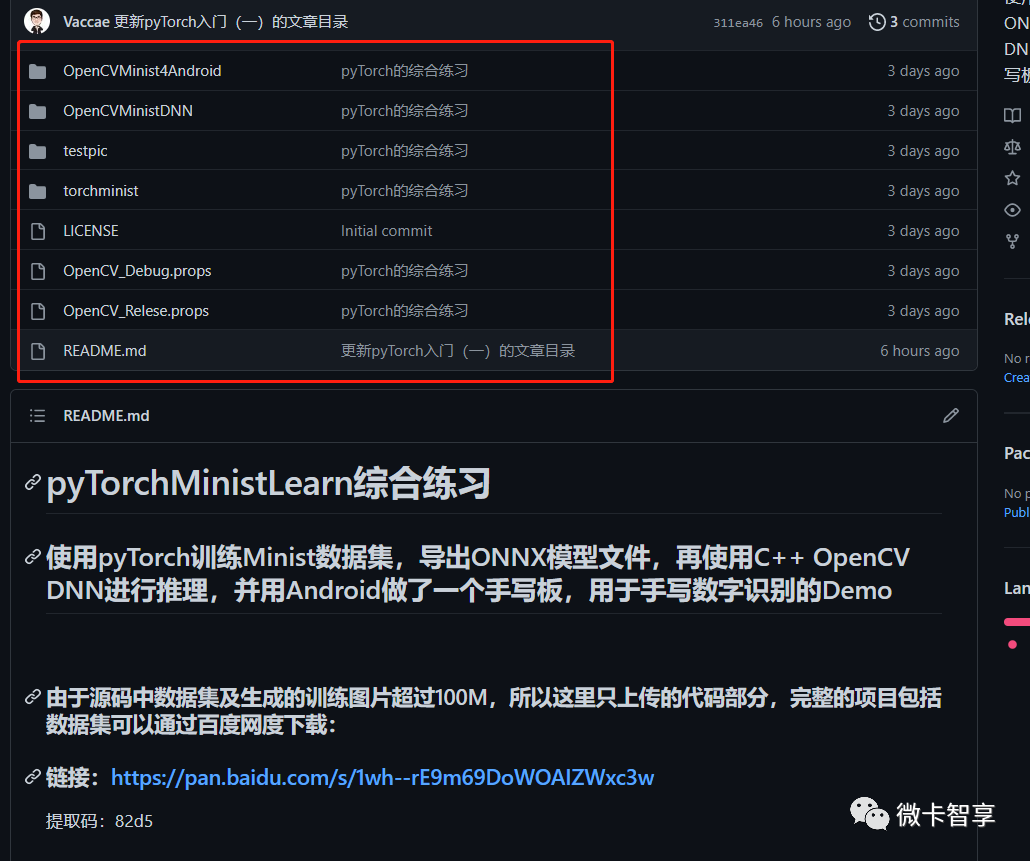
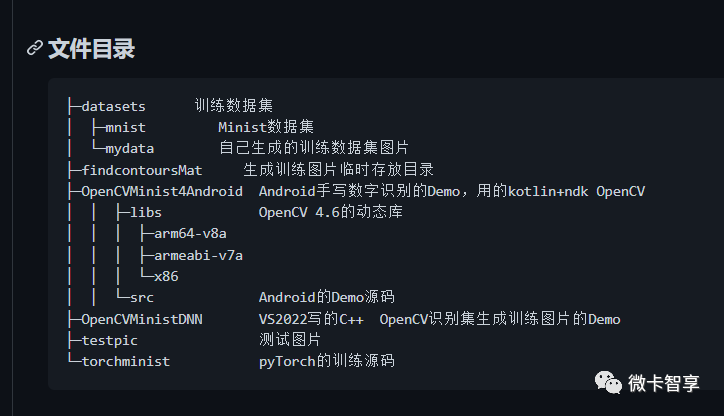
微卡智享
源码地址
https://github.com/Vaccae/pyTorchMinistLearn.git
点击阅读原文可以看到“码云”的代码地址
完


往期精彩回顾
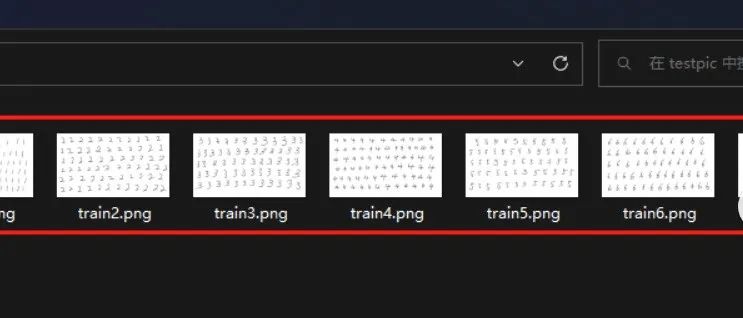
pyTorch入门(五)——训练自己的数据集
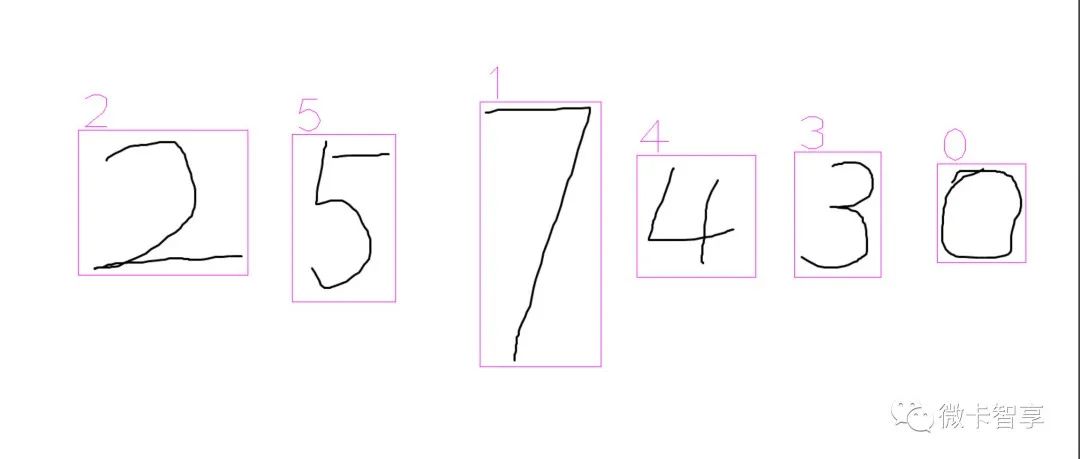
pyTorch入门(四)——导出Minist模型,C++ OpenCV DNN进行识别
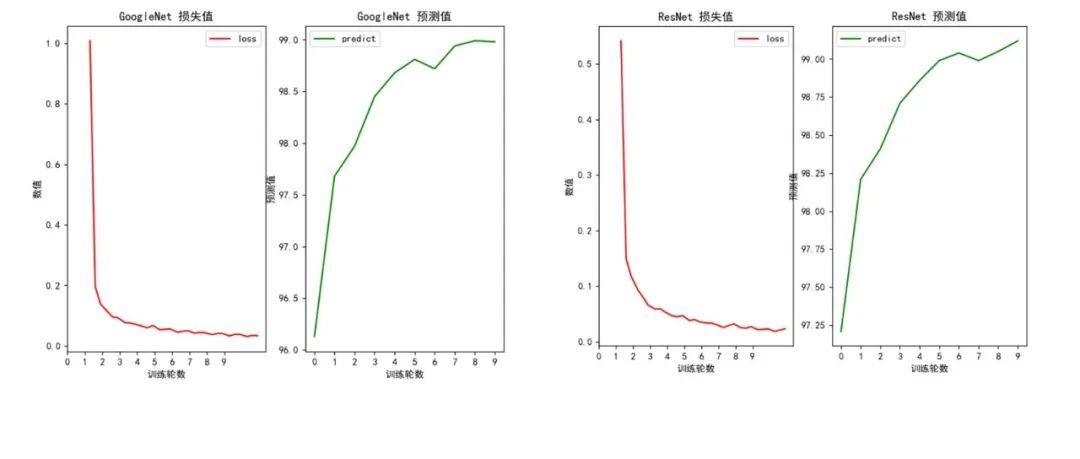
pyTorch入门(三)——GoogleNet和ResNet训练

